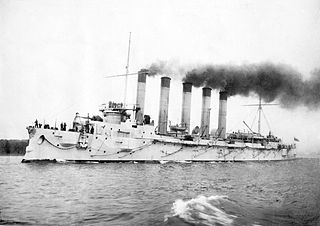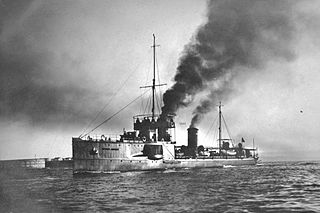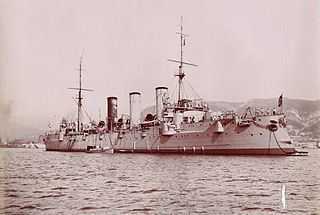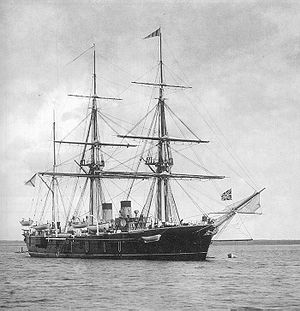
Varyag was a Russian protected cruiser. Varyag became famous for her crew's stoicism at the Battle of Chemulpo Bay.

Mikasa (三笠) is a pre-dreadnought battleship built for the Imperial Japanese Navy (IJN) in the late 1890s. Named after Mount Mikasa in Nara, Japan, the ship served as the flagship of Vice Admiral Tōgō Heihachirō throughout the Russo-Japanese War of 1904–1905, including the Battle of Port Arthur on the second day of the war and the Battles of the Yellow Sea and Tsushima. Days after the end of the war, Mikasa's magazine accidentally exploded and sank the ship. She was salvaged and her repairs took over two years to complete. Afterwards, the ship served as a coast-defence ship during World War I and supported Japanese forces during the Siberian Intervention in the Russian Civil War.

Fuji (富士) was the lead ship of the Fuji class of pre-dreadnought battleships built for the Imperial Japanese Navy by the British firm of Thames Iron Works in the late 1890s. The ship participated in the Russo-Japanese War of 1904–1905, including the Battle of Port Arthur on the second day of the war with her sister Yashima. Fuji fought in the Battles of the Yellow Sea and Tsushima and was lightly damaged in the latter action. The ship was reclassified as a coastal defence ship in 1910 and served as a training ship for the rest of her career. She was hulked in 1922 and finally broken up for scrap in 1948.

Rurik was an armoured cruiser built for the Imperial Russian Navy in the early 1890s. She was named in honour of Rurik, the semi-legendary founder of ancient Russia. She was sunk at the Battle of Ulsan in the Russo-Japanese War of 1904–05.

Askold was a protected cruiser built for the Imperial Russian Navy. She was named after the legendary Varangian Askold. Her thin, narrow hull and maximum speed of 23.8 knots (44.1 km/h) were considered impressive for the time.

Chiyoda (千代田) was a cruiser of the Imperial Japanese Navy, which served in the First Sino-Japanese War, Russo-Japanese War and World War I.

The Bayan class was a group of four armored cruisers built for the Imperial Russian Navy around the beginning of the 20th century. Two of the ships were built in France, as Russian shipyards had no spare capacity. The lead ship, Bayan, was built several years earlier than the later three. The ship participated in several of the early naval battles of the Russo-Japanese War of 1904–05, and provided naval gunfire support for the Imperial Russian Army until she struck a mine. Bayan was trapped in harbor during the subsequent Siege of Port Arthur, and was sunk by Japanese artillery. She was salvaged and put into service with the Imperial Japanese Navy with the name of Aso. She mostly served as a training ship before she was converted into a minelayer in 1920. The ship was sunk as a target in 1932.

The Derzky or Bespokoiny-class destroyers was a class of destroyers built for the Imperial Russian Navy just before World War I. Nine ships were built for the Black Sea Fleet. These ships were a derivative of the Russian destroyer Novik, but were slightly smaller. These ships were popular with the Russians and effective particularly in the Black Sea, where the Ottoman Navy had no similar ships.

The Orfey-class destroyers were built for the Baltic Fleet of the Imperial Russian Navy. They were modified versions of the earlier destroyer Novik and the Derzky-class destroyers. These ships were larger, had triple torpedo tubes and an extra 102 mm (4 in) gun. One ship, Engels, was fitted with a 305 mm (12 in) recoilless rifle for testing in 1934. Fourteen ships were completed in 1914–1917 and fought in World War I and during the Allied intervention in the Russian Civil War. The survivors fought in World War II.

The Izyaslav class were a class of destroyers built for the Baltic Fleet of the Imperial Russian Navy. They were modified versions of the Orfey class built in Russia with the assistance of the French company Augustin Normand. These ships fought in World War I, Russian Civil War, Estonian War of Independence, and World War II.

General-Admiral was the lead ship of her class of armored cruisers built for the Imperial Russian Navy in the early 1870s. She is generally considered as the first true armored cruiser.

Pallada was the lead ship in the Pallada class of protected cruisers in the Imperial Russian Navy. She was built in the Admiralty Shipyard at Saint Petersburg, Russia. The new class was a major improvement on previous Russian cruisers, although the armor protection was light.

Leytenant Zatsarenny was an Imperial Russian Navy destroyer of the four-strong Leytenant Shestakov class.

Izumrud was a protected cruiser of the Imperial Russian Navy, and the lead ship in the two-ship Izumrud class. Izumrud and her sister ship Zhemchug were based on the German-built Novik.

Pamiat Azova was a unique armoured cruiser built for the Imperial Russian Navy in the late 1880s. She was decommissioned from front line service in 1909, converted into a depot ship and sunk by British torpedo boats during the Baltic Naval War, part of the Russian Civil War.

The Shikishima class was a two-ship class of pre-dreadnought battleships built for the Imperial Japanese Navy in the late 1890s. As Japan lacked the industrial capacity to build such warships herself, they were designed and built in the UK. The ships participated in the Russo-Japanese War of 1904–1905, including the Battle of Port Arthur on the second day of the war. Hatsuse sank after striking two mines off Port Arthur in May 1904. Shikishima fought in the Battles of the Yellow Sea and Tsushima and was lightly damaged in the latter action, although shells prematurely exploded in the barrels of her main guns in each battle. The ship was reclassified as a coast defence ship in 1921 and served as a training ship for the rest of her career. She was disarmed and hulked in 1923 and finally broken up for scrap in 1948.

Oleg was the 4th and final Bogatyr-class protected cruiser built for the Imperial Russian Navy.

The Pallada-class cruisers were a group of three protected cruisers built for the Imperial Russian Navy (IRN) in the late 1890s. One ship of the class, Aurora, is still crewed by the Russian Navy, and maintained as a museum ship.

The Russian cruiser Svetlana was a protected cruiser of the Imperial Russian Navy. She was the flagship of the Commander-in-Chief of the Imperial Russian Navy and was used as a royal yacht in peacetime. She was sunk in combat during Battle of Tsushima in the Russo-Japanese War.

The cruiserBogatyr, launched 1901, was the lead ship of the Bogatyr class of four protected cruisers built between 1898 and 1907 for the Imperial Russian Navy.



















